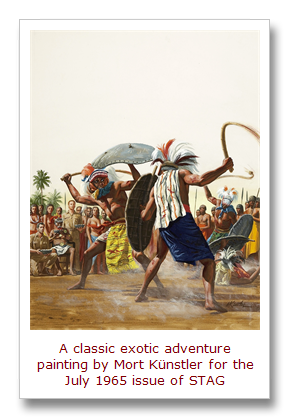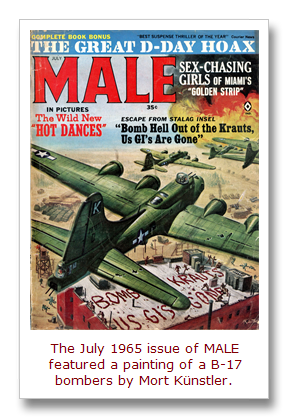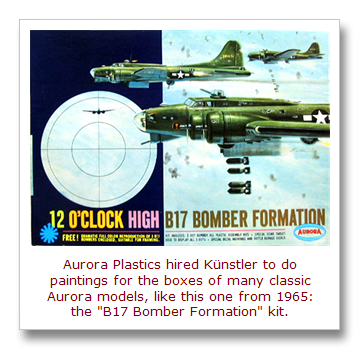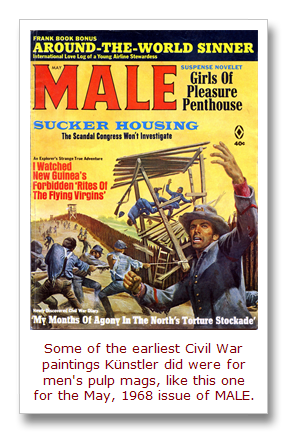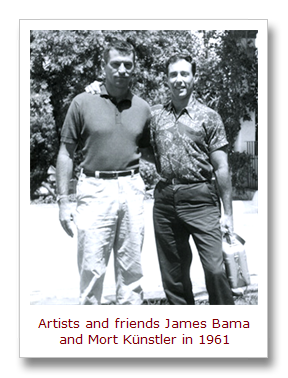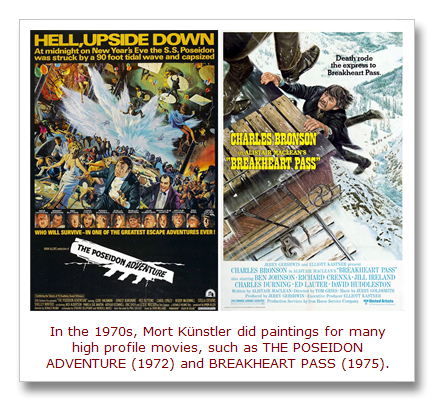Today, Mort Künstler is known as one of the premier historical artists in America. Since the 1980s, his main focus has been on paintings of scenes from American history, especially Civil War scenes.
Mort is also one of the greatest of the many great artists who created cover paintings and interior illustrations for men’s adventure magazines in the 1950s and 1960s. So, I was thrilled when I got a chance to interview him recently.
You can read the Part 1 of my interview with Mort at this link.
Here’s part two…
* * * * * * * * * *
Mort, you did a lot of history-related cover paintings and illustrations for men’s adventure magazines in the ‘50s and ‘60s. Did that help prepare you for your later historic paintings, like your Civil War art?
MORT – Oh yes, there’s no way I could have done what I’m doing today if I hadn’t of had that all that men’s adventure magazine work in the 1950s and 1960s. I learned how to compose, how to tell a story. The work I did for the men’s adventure magazines helped prepare me for all of the work I did later, including advertising art and movie posters and historical paintings. I remember I did all these historical paintings for ads around 1976, relating to the bicentennial of the country. Historical paintings for banks, chemical companies, and so forth. There was no way without the background and training I got from doing the men’s adventure magazine art that I could’ve done that, or the illustrations I did for National Geographic, or the historical paintings that I do now.
I wasn’t aware of your advertising work until I saw the examples on your website. Was that something you got into after the men’s adventure magazines went out of business in the early 1970s?
MORT – Yes, the ‘70s and ‘80s were my heaviest advertising period, where I just turned out tons of advertising art. I don’t even have any idea how much. I seem to go through periods, about 15 to 20 years, where one kind of art dominates and then the next thing takes over. But there was always some overlapping and I often did several types of art at any given time. During my early men’s adventure period I was also doing a huge amount of Aurora model box art. You know, for those plastic models that kids put together: ships and airplanes, tanks and figures, all sorts of things. The old ones are collectibles now.
Sure, I put together a lot of Aurora models in my early teens back in the 1960s. I saw a list of Aurora models you did paintings for on your Facebook site and I think made quite of few of them. One of my favorites that had one of your paintings on the box cover was the B-17 bomber formation kit. I also made some of the Aurora monster models that featured paintings by your fellow artist James Bama , who also did hundreds of covers and illustrations for the classic men’s adventure mags published by Magazine Management, like STAG, MALE, MEN and FOR MEN ONLY.
MORT – In fact I got Jimmy his first Aurora job. I recommended him for the famous monster model paintings that he did. He was my best friend in that period. We met at the Magazine Management offices and we became very close friends. He was the only artist I knew who was also an athlete, like I was. We also had kind of a similar painting style.
How did you get linked up with Aurora?
MORT – Well, the Aurora Plastics company was located Long Island where I lived, so it would’ve been very easy to solicit them. But, in fact, they solicited me. They saw my men’s adventure covers, including some of the ones I did with airplanes and contacted me. I ended up doing more Aurora box covers than any other artist.
How much direction were you given for the cover paintings and illustrations you did for the men’s adventure magazines?
MORT – It worked very simply. The editors would write a paragraph outlining the story concept, or a writer would submit an outline for a story and they’d accept it. They’d show me that. Then I’d do some sketches for approval before doing the painting. I would go into their art department, and they’d have a desk there, and drawing table and supplies, and I’d read this one little paragraph and then I would make a sketch on tracing paper, a quick sketch in charcoal. Two or three sometimes. Then I’d give them to the art director and he would bring them into the editors.
Larry Graber was the Art Director at Magazine Management for most of the ‘50s and ‘60s, right?
MORT – Yes, a lovely man. A wonderful man. He’s still alive and living in New York. He was a very important person in my life during that period. He’s the guy who told me Magazine Management would give me as much work as I wanted early in my career. And, for more than fifteen years, most of the men’s adventure work I did was for Magazine Management magazines, like STAG and MALE and FOR MEN ONLY. Anyway, I would give Larry a sketch based on a story idea he showed me. Then he’d show it to the editors. One editor was Noah Sarlat and the other was Bruce Jay Friedman. And, we would talk it over before showing it to Martin Goodman, the publisher. Mr. Goodman would have final approval.
Did your artwork also influence the stories?
MORT – Yes, especially at Magazine Management, very often the final stories were tailored after my art. Even Mario Puzo, who worked there before he became famous from writing The Godfather, would sometimes write stories based on what my pictures showed.
One of my favorite military aviation cover paintings of yours was for the July 1965 issue of MALE. It went with a story Mario Puzo wrote under his usual pseudonym at the time, Mario Cleri. You also did the interior illustration for that one. When you did other types of scenes that had people in them did you use models?
MORT – Yes, once sketches were approved, I’d go right from the Magazine Management offices to a studio that was nearby in New York, and photograph the models that would help me with my paintings. I wasn’t married to the photographs. They were just an aid. But I would just take a couple of photos of each pose, zing zing, and go home. I had my own darkroom at that time and I would develop the film and make the proofs. That was the next day. And, then it was just a matter of combining everything into one scene. If it required a man and a woman together, I’d call a woman and a man and book them for an hour. I’d have a half an hour with the guy alone, then the next half hour she would come in and they’d pose together and then I’d have her alone for some shots. But the key to what I did was the composition and lighting in the final painting. I used all of the elements that the old masters used — perspective, light and dark values and color. There were so many things that went into those pictures.
Did you have any favorite models that you worked with for your men’s adventure art?
MORT – Oh yeah, sure. Steve Holland was a favorite of everybody’s. He’s been written up in stories by any number of artists. I used him for everything, from an old man to a kid. If I had a crowd scene, with a fat guy, and a short guy, and a thin guy, and a bald guy, and a guy with glasses — Steve was my model for everyone. He was so good, he’d get the feel of each character, and I’d get a few shots of that and then I’d roll right through the others. He also posed for me when I was in my advertising art period. He’d come out to the house here and pose for me then. I loved Steve. He was a sweetheart of a guy and a wonderful model. And, to this day now, I’m still using some of the old photos I took of him. I’ve very rarely taken photos for the last 20 years. I was hired to do art for a number of Civil War films, like the movie GETTYSBURG and the movie GODS AND GENERALS, and so I ended up with a bunch of stills that helped me with my Civil War art.
Of course, Steve Holland was also a special favorite of Jim Bama, who used him as the model for his DOC SAVAGE paperback cover paintings and countless men’s adventure illos. Were there particular kinds of men’s adventure scenes you liked to paint?
MORT – I liked making pictures for stories that were believable. I did paint pictures for a lot of stories that were absolutely unbelievable. I think those were the most difficult. But I tried to make those pictures look real, too. And, I guess that’s what I’m best known for, as it turns out.
How many paintings did you do in a typical month for Mag Management?
MORT – They just flooded me with work. Every month I usually did three covers and two inside illustrations for Magazine Management. And, then of course there were sometimes these book bonus assignments. I noticed the example you published on your blog, the series of illustrations I did for HIS MAJESTY O’KEEFE. Each book bonus like that would have six or eight pictures.
You seem to have done a wider range of paintings than most other men’s adventure artists, from animal attack scenes and panoramic battles to history and adventure scenes, paintings of spies, criminals, sexy women. Just about every subject commonly featured in men’s adventure mags.
MORT – That’s why I was paid more. I was paid twice as much as most of the other artists because I could basically paint anything. It was pretty easy to do a couple of figures in a scene. I could do those in a day. But a lot other artists couldn’t do things like big battle scenes. I once asked “Why am I getting this assignment?” And they said “Because so-and-so can’t do it.” I said, “Then I should be getting paid more. I’m being punished for being better.’ And, they thought it over and said, “You’re right.”
Magazine Management publisher Martin Goodman seemed to have a knack for picking good artists and writers.
MORT – I’ll tell you something he did that was remarkable. I did a painting for a fiction piece called “The President’s Plane is Missing.” It was a novel. And, I did a cover and an inside illustration for it. And, it was a cover that was one of these very complex scenes. And, it was one of the best that I ever did really. And, I was being paid as I said about twice as much as most other artists for the covers, and I got a letter out of the blue from Mr. Goodman, and it had a check in it for a hundred dollars. And he said “Mort, I want you to know I saw that painting and I think it’s one of the best paintings that you ever did. And, as a token of my appreciation, I would like you to accept this check.” That was so unusual and a hundred bucks wasn’t bad in those days. It never happened to me from anyone else.
I have that issue. It was the February 1969 issue of STAG.
MORT – I’ll always remember that one. Mr. Goodman told me, “I have no way to know how your painting might affect sales, but I just wanted you to know how much I appreciate it.” Isn’t that something?
My impression is that men’s adventure magazines, and especially Goodman and Magazine Management mags, were important to a lot of illustration artists in the ‘50s and ‘60s, since most other magazines had moved to using photos for their covers and stories.
MORT – Oh my God, yes. I went through the whole ‘60s with them, as did a lot of other artists. And, then in the early ‘70s, the men’s adventure magazines died out. I gradually replaced that work with work that actually paid a lot more, the advertising art and movie posters, which took me into the ‘80s. My first art gallery show of historic paintings was in 1977. And, that started a whole new phase of my career that took me all the way through to now. We could all foresee that the men’s adventure magazines would be gone and paperbacks took their place to some extent, for a while. I never did that many paperbacks, though maybe more than a lot of other artists, because I could do the simple, covers with one or two people pretty quickly. But I never thought of myself as a paperback artist. I just had a couple of companies that loved my work and they’d pay me a substantial amount and they’d give me a lot of time.
You also did movie posters for some great movies, like THE POSEIDON ADVENTURE and BREAKHEART PASS.
MORT – The movie posters were the best paying art in the entire business, actually. Poster assignments were very much sought after. I did a lot of posters for adventure films, similar to the covers I had been doing for Magazine Management.
You seem almost as busy now as at any time in your career. Between your commissioned paintings, your limited edition prints, a series of books and other things I see on your main website and your vintage illustrations website, you have quite an empire going nowadays.
MORT – Yeah, it’s amazing to me. We have three people who work here, in a separate building. And, it’s just all I can do to keep up with things. As a matter of fact, I think I was happier when I just painted pictures, instead of doing things like dealing with licensing arrangements. But unfortunately — and fortunately — I’m very busy now. It sure as hell beats being ignored, doesn’t it?
I’ve noticed that you’re still doing new paintings on a regular basis.
MORT – Yes, I take more time doing a painting now, but I keep getting commissions for new ones. I just finished a painting on George Washington commissioned by the Adjutant Generals Schools of the U.S. Army, their alumni association. They had a military ball where the painting was unveiled. [NOTE: This new painting is now available as a limited edition print on Mort’s website.] I get a lot of commissions like that now. Right now I’m discussing commissions that will take me until next July to fulfill. It’s kind of hard to believe, from those humble beginnings of mine on Long Island to where I am today. Frankly, I think I’ve got the best racket in the world because, if I were retired, I’d want to paint pictures. So, you could almost say I’ve been retired all these years and I’m being paid for pursuing my hobby.
* * * * * * * * * *
Thanks again to Mort Künstler for taking the time to talk with me – and to his daughter Jane for linking me up with him.
Also, thanks to Mort’s staff for their help – and to men’s adventure art collector Rich Oberg for some of the images shown here.
* * * * * * * * * *
Comments? Corrections? Post them on the Men’s Adventure Magazines Facebook Group.
Check out our Men’s Adventure Library series on Amazon by clicking this link or the image below.


